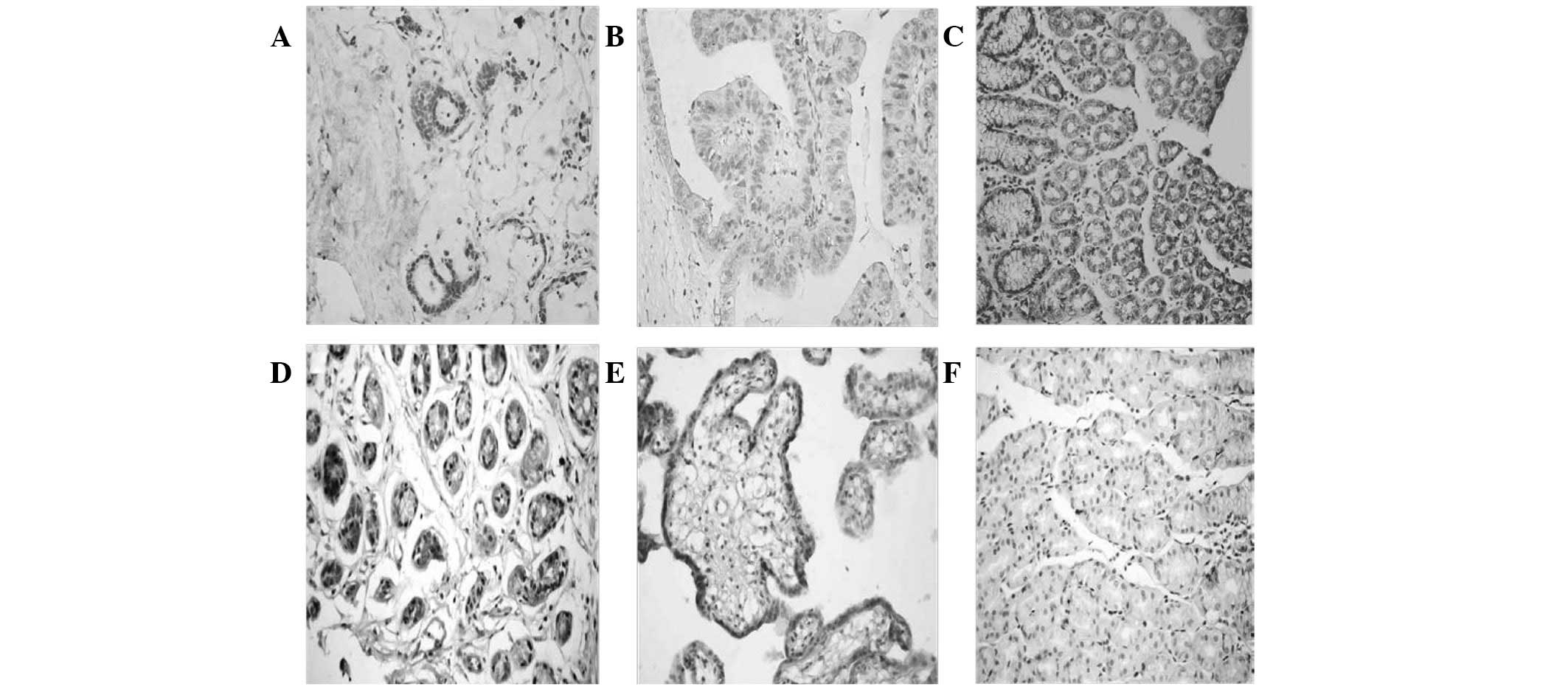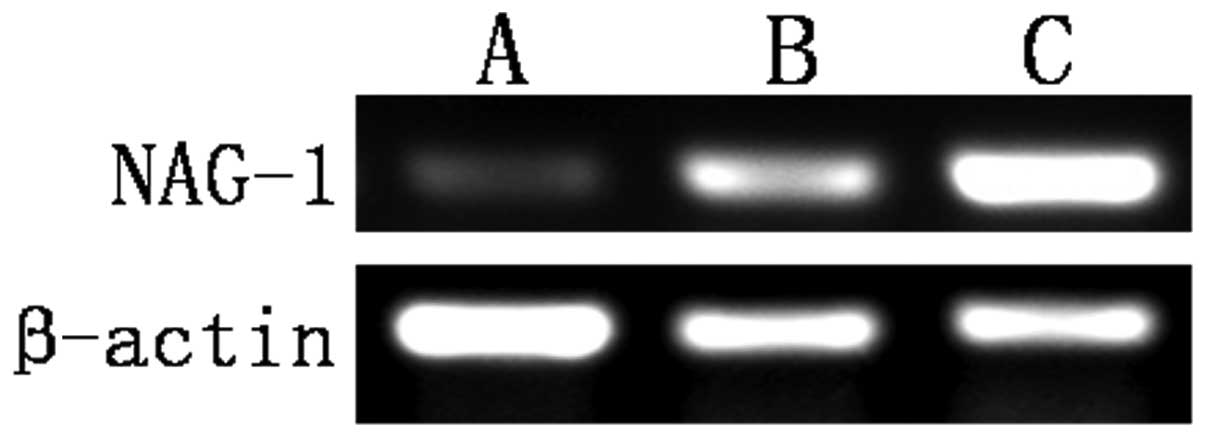|
1
|
Wang R, Guo L, Wang P, et al:
Chemoprevention of cancers in gastrointestinal tract with
cyclooxygenase 2 inhibitors. Curr Pharm Des. 19:115–125.
2012.PubMed/NCBI
|
|
2
|
Wang C, Wang J and Bai P: Troglitazone
induces apoptosis in gastric cancer cells through the NAG-1
pathway. Mol Med Rep. 4:93–97. 2011.PubMed/NCBI
|
|
3
|
Lee DH, Yang Y, Lee SJ, et al: Macrophage
inhibitory cytokine-1 induces the invasiveness of gastric cancer
cells by up-regulating the urokinase-type plasminogen activator
system. Cancer Res. 63:4648–4655. 2003.PubMed/NCBI
|
|
4
|
Park JY, Park KH, Bang S, Kim MH, Koh SS
and Song SY: Expression of nonsteroidal anti-inflammatory
drug-activated gene-1 (NAG-1) inversely correlates with tumor
progression in gastric adenomas and carcinomas. J Cancer Res Clin
Oncol. 134:1029–1035. 2008. View Article : Google Scholar : PubMed/NCBI
|
|
5
|
Baek SJ, Kim KS, Nixon JB, Wilson LC and
Eling TE: Cyclooxygenase inhibitors regulate the expression of a
TGF-beta superfamily member that has proapoptotic and
antitumorigenic activities. Mol Pharmacol. 59:901–908.
2001.PubMed/NCBI
|
|
6
|
Baek SJ, Wilson LC and Eling TE:
Resveratrol enhances the expression of non-steroidal
anti-inflammatory drug-activated gene (NAG-1) by increasing the
expression of p53. Carcinogenesis. 23:425–434. 2002. View Article : Google Scholar : PubMed/NCBI
|
|
7
|
Wilson LC, Baek SJ, Call A and Eling TE:
Nonsteroidal anti-inflammatory drug-activated gene (NAG-1) is
induced by genistein through the expression of p53 in colorectal
cancer cells. Int J Cancer. 105:747–753. 2003. View Article : Google Scholar : PubMed/NCBI
|
|
8
|
Bottone FG Jr, Baek SJ, Nixon JB and Eling
TE: Diallyl disulfide (DADS) induces the antitumorigenic
NSAID-activated gene (NAG-1) by a p53-dependent mechanism in human
colorectal HCT 116 cells. J Nutr. 132:773–778. 2002.PubMed/NCBI
|
|
9
|
Lee SH, Kim JS, Yamaguchi K, Eling TE and
Baek SJ: Indole-3-carbinol and 3,3′-diindolylmethane induce
expression of NAG-1 in a p53-independent manner. Biochem Biophys
Res Commun. 328:63–69. 2005.
|
|
10
|
Newman D, Sakaue M, Koo JS, et al:
Differential regulation of nonsteroidal anti-inflammatory
drug-activated gene in normal human tracheobronchial epithelial and
lung carcinoma cells by retinoids. Mol Pharmacol. 63:557–564. 2003.
View Article : Google Scholar : PubMed/NCBI
|
|
11
|
Baek SJ, Kim JS, Nixon JB, DiAugustine RP
and Eling TE: Expression of NAG-1, a transforming growth
factor-beta superfamily member, by troglitazone requires the early
growth response gene EGR-1. J Biol Chem. 279:6883–6892. 2004.
View Article : Google Scholar : PubMed/NCBI
|
|
12
|
Li PX, Wong J, Ayed A, et al: Placental
transforming growth factor-beta is a downstream mediator of the
growth arrest and apoptotic response of tumor cells to DNA damage
and p53 overexpression. J Biol Chem. 275:20127–20135. 2000.
View Article : Google Scholar : PubMed/NCBI
|
|
13
|
Bootcov MR, Bauskin AR, Valenzuela SM, et
al: MIC-1, a novel macrophage inhibitory cytokine, is a divergent
member of the TGF-beta superfamily. Proc Natl Acad Sci USA.
94:11514–11519. 1997. View Article : Google Scholar : PubMed/NCBI
|
|
14
|
Hromas R, Hufford M, Sutton J, Xu D, Li Y
and Lu L: PLAB, a novel placental bone morphogenetic protein.
Biochim Biophys Acta. 1354:40–44. 1997. View Article : Google Scholar : PubMed/NCBI
|
|
15
|
Paralkar VM, Vail AL, Grasser WA, et al:
Cloning and characterization of a novel member of the transforming
growth factor-beta/bone morphogenetic protein family. J Biol Chem.
273:13760–13767. 1998. View Article : Google Scholar : PubMed/NCBI
|
|
16
|
Böttner M, Laaff M, Schechinger B, Rappold
G, Unsicker K and Suter-Crazzolara C: Characterization of the rat,
mouse, and human genes of growth/differentiation
factor-15/macrophage inhibiting cytokine-1 (GDF-15/MIC-1). Gene.
237:105–111. 1999.PubMed/NCBI
|
|
17
|
Bauskin AR, Zhang HP, Fairlie WD, et al:
The propeptide of macrophage inhibitory cytokine (MIC-1), a
TGF-beta superfamily member, acts as a quality control determinant
for correctly folded MIC-1. EMBO J. 19:2212–2220. 2000. View Article : Google Scholar : PubMed/NCBI
|
|
18
|
Tan M, Wang Y, Guan K and Sun Y:
PTGF-beta, a type beta transforming growth factor (TGF-beta)
superfamily member, is a p53 target gene that inhibits tumor cell
growth via TGF-beta signaling pathway. Proc Natl Acad Sci USA.
97:109–114. 2000. View Article : Google Scholar : PubMed/NCBI
|
|
19
|
Liu T, Bauskin AR, Zaunders J, et al:
Macrophage inhibitory cytokine 1 reduces cell adhesion and induces
apoptosis in prostate cancer cells. Cancer Res. 63:5034–5040.
2003.PubMed/NCBI
|
|
20
|
Lambert JR, Kelly JA, Shim M, et al:
Prostate derived factor in human prostate cancer cells: gene
induction by vitamin D via a p53-dependent mechanism and inhibition
of prostate cancer cell growth. J Cell Physiol. 208:566–574. 2006.
View Article : Google Scholar : PubMed/NCBI
|
|
21
|
Baek SJ, Okazaki R, Lee SH, et al:
Nonsteroidal anti-inflammatory drug-activated gene-1 over
expression in transgenic mice suppresses intestinal neoplasia.
Gastroenterology. 131:1553–1560. 2006. View Article : Google Scholar : PubMed/NCBI
|
|
22
|
Brown DA, Ward RL, Buckhaults P, et al:
MIC-1 serum level and genotype: associations with progress and
prognosis of colorectal carcinoma. Clin Cancer Res. 9:2642–2650.
2003.PubMed/NCBI
|
|
23
|
Senapati S, Rachagani S, Chaudhary K,
Johansson SL, Singh RK and Batra SK: Overexpression of macrophage
inhibitory cytokine-1 induces metastasis of human prostate cancer
cells through the FAK-RhoA signaling pathway. Oncogene.
29:1293–1302. 2010. View Article : Google Scholar : PubMed/NCBI
|
|
24
|
Kim KK, Lee JJ, Yang Y, You KH and Lee JH:
Macrophage inhibitory cytokine-1 activates AKT and ERK-1/2 via the
transactivation of ErbB2 in human breast and gastric cancer cells.
Carcinogenesis. 29:704–712. 2008. View Article : Google Scholar : PubMed/NCBI
|
|
25
|
Baek KE, Yoon SR, Kim JT, et al:
Upregulation and secretion of macrophage inhibitory cytokine-1
(MIC-1) in gastric cancers. Clin Chim Acta. 401:128–133. 2009.
View Article : Google Scholar : PubMed/NCBI
|
|
26
|
Pang RP, Zhou JG, Zeng ZR, et al:
Celecoxib induces apoptosis in COX-2 deficient human gastric cancer
cells through Akt/GSK3beta/NAG-1 pathway. Cancer Lett. 251:268–277.
2007. View Article : Google Scholar
|
|
27
|
Jang TJ, Kang HJ, Kim JR and Yang CH:
Non-steroidal anti-inflammatory drug activated gene (NAG-1)
expression is closely related to death receptor-4 and -5 induction,
which may explain sulindac sulfide induced gastric cancer cell
apoptosis. Carcinogenesis. 25:1853–1858. 2004. View Article : Google Scholar
|
|
28
|
Mimeault M and Batra SK: Divergent
molecular mechanisms underlying the pleiotropic functions of
macrophage inhibitory cytokine-1 in cancer. J Cell Physiol.
224:626–635. 2010. View Article : Google Scholar : PubMed/NCBI
|
|
29
|
Wang X, Baek SJ and Eling TE: The diverse
roles of nonsteroidal anti-inflammatory drug activated gene
(NAG-1/GDF15) in cancer. Biochem Pharmacol. 85:597–606. 2013.
View Article : Google Scholar : PubMed/NCBI
|
|
30
|
Kim KS, Baek SJ, Flake GP, Loftin CD,
Calvo BF and Eling TE: Expression and regulation of nonsteroidal
anti-inflammatory drug-activated gene (NAG-1) in human and mouse
tissue. Gastroenterology. 122:1388–1398. 2002. View Article : Google Scholar : PubMed/NCBI
|
|
31
|
Kadowaki M, Yoshioka H, Kamitani H,
Watanabe T, Wade PA and Eling TE: DNA methylation-mediated
silencing of nonsteroidal anti-inflammatory drug-activated gene
(NAG-1/GDF15) in glioma cell lines. Int J Cancer. 130:267–277.
2012. View Article : Google Scholar : PubMed/NCBI
|











